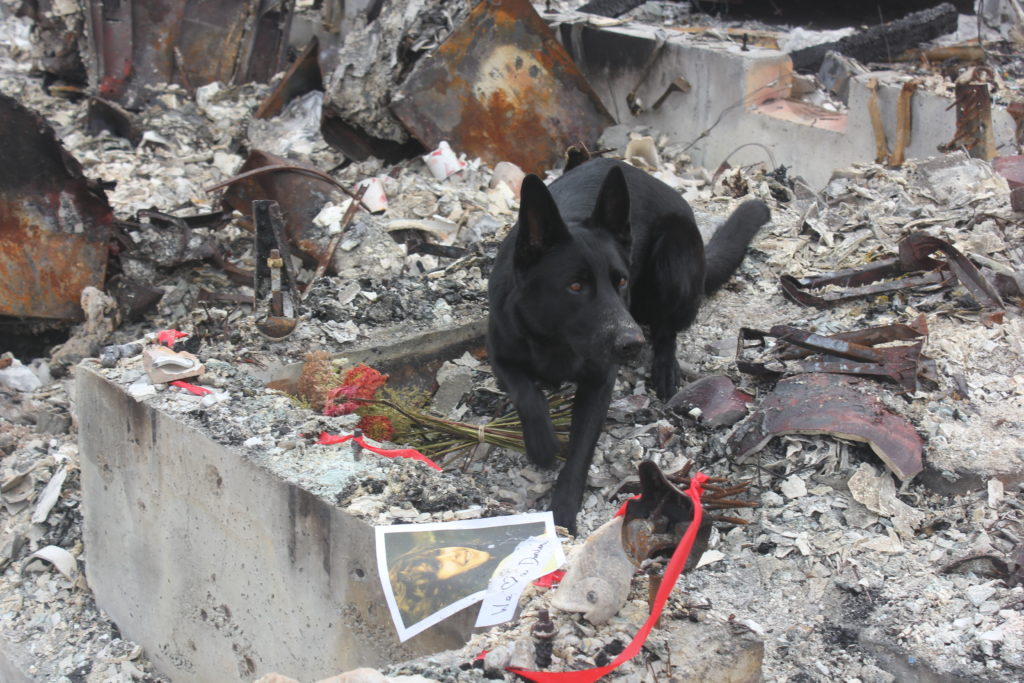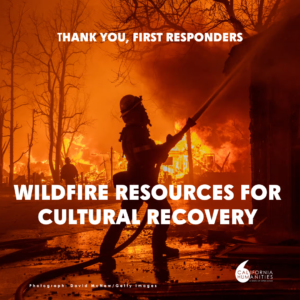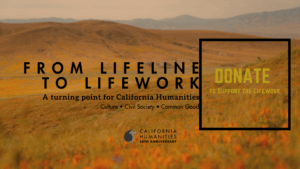“The power of community that this project highlights is important right now as it helps us remember that humans are resilient, strong, and better together.”–Dana Shew
As people flee from threatening wildfires, frantically waking family members and collecting pets and belongings from their homes, the ashes of cremated loved ones (cremains) are more often than not left behind. In the tragic event that homes are lost to these increasingly destructive and frequent fires, the inadvertently overlooked cremated remains become part of the charred remnants of people’s homes, almost indistinguishable from the burnt debris. Anything that is not salvaged afterward from the wreckage is considered toxic waste and disposed of, including the lost ashes of loved ones.
Supported by a Humanities for All Project Grant, the “Ashes from Ashes: Recovering Cremains from the Wreckage of California Wildfires” project aims to capture the stories and reflections of archaeologists, dog handlers, and affected families. Interviews and footage from cremains recoveries will be made into a video for screenings, panel discussions, and other public events in communities around the state. In this blog post, California Humanities’ Project and Evaluation Director Felicia Kelley talks with “Ashes from Ashes” Project Director, Dana Shew, to learn more about her inspiration for the project and the process and people involved.
What inspired you to create this project?
I was first inspired to create this project when I saw a paper given by archaeologist Alex DeGeorgey at the Society for California Archaeology annual conference in 2018. His report relayed the emotional, rewarding, and humbling work that the cremains recovery teams had conducted during the aftermath of the 2017 Tubbs Fire. It was an incredibly moving and inspiring story for so many reasons that I immediately knew that the experiences of all those involved needed to be recorded and shared with the public.
Please tell us more about the cremains recovery process. How does it work, and who is involved?
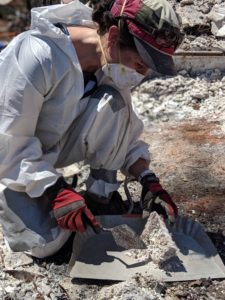
The first step in the cremains recovery process involves getting the word out to affected families and homeowners, letting them know that this service is available. Survivors who have lost their homes are faced with the overwhelming task of wading through paperwork, forms, procedures, and countless decisions on top of trying to secure food and shelter, often while in a prolonged state of shock. Cremains recovery services can often get lost in this shuffle. However, the cremains recovery team has gotten really good at reaching these communities and is very proactive in connecting to those hoping to recover the cremated ashes of loved ones.
The actual cremains recovery process starts with an interview with the homeowner to determine precisely where the cremains were kept in the house and what type of container they were kept in. This helps the recovery team, made up of professional archaeologists and canine forensic teams, focus their search efforts. The dogs are first up. If there is more than one dog, they each take a turn surveying the area with their handlers. If a scent is picked up, the dogs will alert by sitting down at the location of the scent. These locations are noted, and once the dogs are done, the archaeologists begin carefully removing debris, methodically clearing the search area using their hands and trowels. Once archaeologists locate the cremains, they are gently removed from the debris, placed into a plastic bag, and handed over to family members. The moment the cremains are returned to the family member is always emotional for everyone involved. The sense of relief, closure, longing, sorrow, hope, and inspiration is palpable and unforgettable.
What have you been learning from the people (the family members, first responders, recovery personnel, including the dog handlers) you’ve been interviewing?
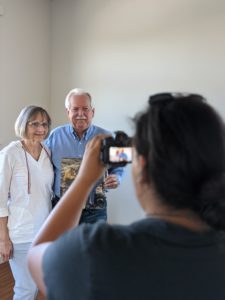
One of the common threads that have surfaced from the interviews with the fire survivors is an appreciation of the non-material things in life. Although their experiences have been devastating and heartbreaking, they have all survived with renewed gratefulness for everything that they do have- memories, supportive family and friends, their health. They have come to terms with their losses and have new perspectives on what they value in life. The one material thing that they could not accept losing was the cremains of their loved ones. The recovery of these ashes provided them with closure and relief that, in many cases, let them move forward, allowing them to let go of the remains of their homes.
For the dog handlers and archaeologists, providing this closure and giving back in such an immediate way has been a powerful and impactful experience. Because archaeologists typically deal with the deep past, being able to use their skills in a situation that helps and affects people’s lives right in front of them is a rare and special opportunity. The canine teams have also been affected by the deeply personal and intense nature of the cremains recoveries. Not only have the dog handlers been moved and changed by these experiences, but the dogs themselves react to the emotionally charged atmosphere of the recoveries. They can sense the anxiety and nervous energy in the air and often provide much-needed comfort and relief. These emotional connections make the contributions of archaeology and canine forensics even more meaningful and personal, and the sheer number of volunteers is evidence that these connections are important and desired experiences to professionals in these fields.
What do you hope the audience(s) will take away from viewing the documentary, the website, and participating in the community dialogues?
I hope that audiences who view the interviews, read the stories, and participate in community dialogues will come away feeling hopeful through witnessing resilience. I hope they are healed through sharing their own stories, comforted by realizing they are not alone, and inspired by the power of community to help, continue learning, and motivate change.
Why is this project important right now, and how does it connect to the humanities and society?
This project is important right now because wildfires have become a part of the California experience. The aftermath of these devastating events has touched us all, whether directly or indirectly, and therefore, it is OUR story. It reaches beyond California since climate change, a significant cause for the increase in frequency and severity of wildfires, is a global issue. We can learn from those who have survived and use these lessons to make positive changes. The power of community that this project highlights is important right now as it helps us remember that humans are resilient, strong, and better together.
View the trailer for the “Ashes from Ashes: Recovering Cremains from the Wreckage of California Wildfires” Project below.

